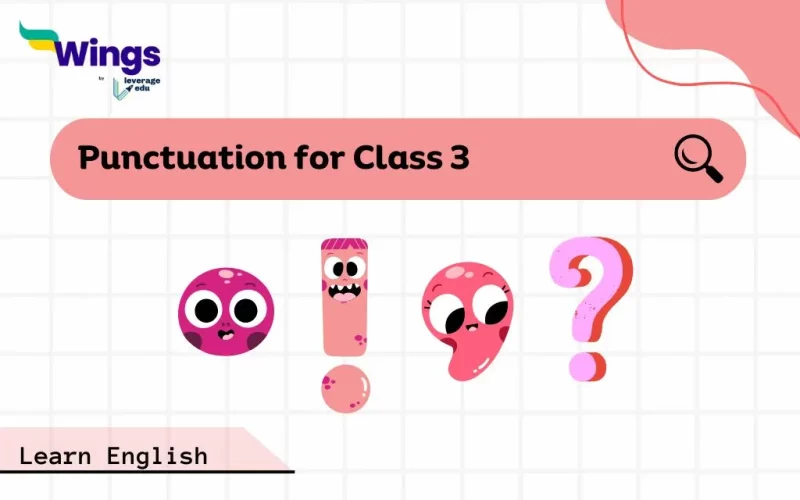Punctuation for Class 3: Punctuation marks are the secret agents that make your writing clear, exciting, and easy to understand. They are more like traffic signals, guiding readers through your sentences, and find out when to stop, slow down, or take a sharp turn. Just like you would not want to cross a busy street without a stop sign, you would not want your readers to get confused without proper punctuation. So, what are these punctuation powerhouses all about? This blog will introduce you to some of the most common punctuation marks you will use in Grade 3 and beyond to strengthen your knowledge of English grammar.
This Blog Includes:
Button: Punctuation: A Quick Guide
Punctuation for Class 3 – Definition
As per the standard definition, punctuation marks help in providing direction and meaning to your sentence formations. To elaborate, it specifies whether it is an interrogatory statement, command or a polite request with the help of a few punctuation symbols. You can convert the same message in various tones with a change of punctuation:
- Tamas is a book written by Bhisham Sahni.
- (Is) Tamas a book written by Bhisham Sahni?
Did you notice? The first sentence is a statement, whereas the second one is an inquiry, following a different punctuation mark.
Types of Punctuation for Class 3 – Uses and Examples
There are so many punctuation marks you are sure to encounter while improving your English language learning in future. However, hereon we will focus on the types of punctuation that every kid ought to know in Grade 3 with the help of examples.
Full Stop (.)
Full stop, also known as period comes at the end of a sentence to indicate a statement or a command. It is denoted with a “.” after the end of every declaration, implying the end of discussion.
Here are some more examples of full stops within a sentence:
- I love pizza.
- My dog is brown and fluffy.
- We play outside after school.
Question Mark (?)
A question mark denotes a conversation involving any question or inquiry about something or someone. Take a look at the examples below for reference:
- What is your favourite colour?
- Do you want to play?
- Can I have a cookie, please?
Exclamation Mark (!)
An exclamation mark specialises in denoting a strong sense of excitement, happiness, surprise, or other emotions in sentences. An inverted i, “!” is symbolic of this punctuation, thus, making a sentence exclamatory.
Comma (,)
Unlike full stops, commas offer a small break within a long sentence at different parts. It helps the reader in easy comprehension of a sentence or paragraph with the symbol “,”. Here are some examples of comma punctuation you may see for reference.
- I like apples, oranges, and bananas.
- We went to the park, had lunch, and then played frisbee.
- My favourite things to do are read, draw, and play with my friends.
Punctuation for Class 3: Capital Letters in Punctuation
Although capital letters are not formally a type of punctuation, you must recognize their role while using punctuation in English. Capitalising the first word of a sentence and proper nouns (i.e., names of people, places, and things) is mandatory. Remember to leave a space after each punctuation mark, except for periods after initials.
Punctuation for Class 3 Students: Exercise
So far you have learnt what are punctuation marks and how to use them with the help of examples. Now, let’s test your knowledge of these grammatical tools through the following practice exercises.
Exercise 1 – Punctuate the Following Sentences
- I love to play outside
- My favourite colour is blue
- We went to the zoo yesterday
- Have you seen my new puppy
- The sun is shining brightly today
Exercise 2 – Rewrite the Following Sentences with Punctuation
- i like to eat apples bananas and oranges
- yesterday we went to the park played games and had a picnic
- my friend has a dog a cat and a rabbit
- the bird chirped loudly early in the morning
- i am excited to go on vacation to the beach
Find out more about Punctuation Here!
FAQs
Ans: Punctuation marks are like tiny traffic signals for our sentences. They tell us when to stop (full stop), pause (comma), ask a question (question mark) or show strong feelings (exclamation mark). They help us write clearly and make our writing super easy to understand!
Ans: You will learn about the following punctuation marks in Class 3:
Full stop (.)
Question mark (?)
Comma (,)
Capital letter (A)
Ans: Imagine reading a sentence with no punctuation marks at all! It would be like trying to understand someone talking super fast without taking any breaths. Punctuation helps us understand the meaning of a sentence and even how it’s said, like with excitement or sadness.
This was all about the punctuation for class 3 and related information. Hope you understand the concept and know how to proceed. You can also follow the page of Learn English on Leverage Edu website for more exciting and informative blogs.
 One app for all your study abroad needs
One app for all your study abroad needs














 45,000+ students realised their study abroad dream with us. Take the first step today.
45,000+ students realised their study abroad dream with us. Take the first step today.
